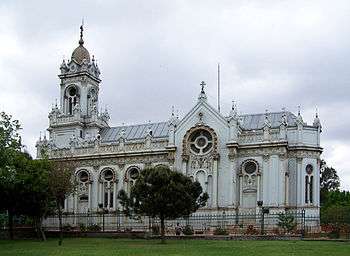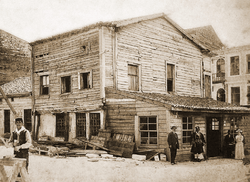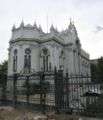Bulgarian St. Stephen Church

The Bulgarian St Stephen Church (Bulgarian: Църква „Свети Стефан“; Turkish: Sveti Stefan Kilisesi), also known as the Bulgarian Iron Church, is a Bulgarian Orthodox church in Fatih, Istanbul, Turkey, famous for being made of prefabricated cast iron elements in the neo-Gothic style. The church belongs to the Bulgarian minority in the city. The Bulgarians of the Ottoman Empire used to pray at the churches of the Phanar Orthodox Patriarchy, but due to nationalistic movements, Bulgarians were allowed a national church in the 19th century, the Bulgarian Exarchate.
The richly ornamented church is a three-domed cross-shaped basilica. The altar faces the Golden Horn and a 40 m-high belfry, the six bells of which were cast in Yaroslavl, rises above the narthex. Initially, a small wooden church was erected on the shore of the Golden Horn between Balat and Fener squares (near Eyüp district), where the current church is located. A house was donated by the statesman Stefan Bogoridi and it was reorganized as a wooden church. It was inaugurated on 9 October 1849 and became an important site of the Bulgarian National Revival. The Ottoman royal decree of 28 February 1870 establishing the Bulgarian Exarchate was first read in the church.

After the original wooden structure suffered from a fire, the larger current building was constructed at its place. An iron frame was preferred to concrete reinforcement due to the weak ground conditions. The construction plans were prepared by Hovsep Aznavur, an Armenian of Istanbul origin. An international competition was conducted to produce the prefabricated parts of the church, won by an Austrian company, R. Ph. Waagner. The prefabricated parts, weighing 500 tons, were produced in Vienna in 1893-1896 and transported to Istanbul by ship through the Danube and the Black Sea.
After one and a half years' work, the church was completed in 1898 and inaugurated by Exarch Joseph on 8 September that year. The main skeleton of the church was made of steel and covered by metal boards. All the pieces were attached together with nuts, bolts, rivets or welding. In terms of architecture, the church combines Neo-Gothic and Neo-Baroque influences.
St. Stephen was the product of 19th century experimentation with prefabricated iron churches. The British, who invented corrugated iron in 1829, manufactured portable iron churches to send to far-flung colonies like Australia. The Eiffel Tower's creator, French engineer Gustave Eiffel, designed iron churches that were sent as far as the Philippines and Peru. Now St Stephen is one of the world's few surviving prefabricated cast iron churches.
On December 27, 2010, Saint Stephen's feast day, a celebratory mass was held at the church in honor of its patron saint. Attending were the Vratsa metropolitan Kalinik, bishop Naum, Chief Secretary of the Bulgarian Holy Synod, and representatives of the "St. Stephen Church" Foundation. Honoring the celebration the dome of the church was gold-plated using funds donated by the Bulgarians of Plovdiv.[1]
In addition to the St. Stephen Church, there is another Bulgarian Orthodox church in Istanbul—the St. Demetrius Church in Feriköy.
Burials
Gallery
 Iron church St Stefan 1898
Iron church St Stefan 1898 View from the Golden Horn
View from the Golden Horn Rudolph Philipp Waagner, Vienna, producer of the steel elements
Rudolph Philipp Waagner, Vienna, producer of the steel elements The iconostasis
The iconostasis Interior of St. Stephen Church
Interior of St. Stephen Church
References and external links
- ↑ December 27, 2010. "Bulgarian Iron Church Celebrates Patron Day". Sofia News Agency. Retrieved December 27, 2010.
| Wikimedia Commons has media related to St. Stefan in Istanbul. |
- Information about the church on a site about the Bulgarians in Istanbul (Bulgarian)
- The St Stephen Foundation (English) (Bulgarian) (Turkish)
- A Bulgarian National Radio report also telling the history of the church (Bulgarian)
- Monkeytravel info and photos (incl. detail photo) (English)
- Благовеста Иванова. Църквата "Св. Стефан" край Златния рог и нейните събратя
- Благовеста Иванова, Ради Ганев. "Желязото" и стоманата в храма "Св. Стефан" в Истанбул
- Благовеста Иванова. Неосъщественият каменен храм "Св. Троица" на брега на Златния рог и архитектите Фосати
- Благовеста Иванова. Българските старини в Цариград
- Blagovesta Ivanova, Radi Ganev, Milosh Drdacky. Architectural, Material and Damage Survey of the Bulgarian Metal Church of St. Stefan in Istanbul
- Blagovesta Ivanova, Radi Ganev & Miloš Drdácký. Historical and Condition Survey of the St. Stefan Bulgarian Metal Church in Istanbul
Coordinates: 41°01′55″N 28°56′59″E / 41.03194°N 28.94972°E